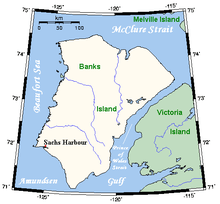Banks Island
 These moderate resolution imaging spectroradiometer images from June 14 and 16, 2002, show Banks Island (upper left) and Victoria Island (to the southeast) | |
 | |
| Geography | |
|---|---|
| Location | Beaufort Sea |
| Coordinates | 73°00′N 121°30′W / 73.000°N 121.500°WCoordinates: 73°00′N 121°30′W / 73.000°N 121.500°W |
| Archipelago | Canadian Arctic Archipelago |
| Area | 70,028 km2 (27,038 sq mi) |
| Area rank | 24th |
| Length | 380 km (236 mi) |
| Width | 290 km (180 mi) |
| Highest elevation | 730 m (2,400 ft) |
| Highest point | Durham Heights |
| Country | |
|
Canada | |
| Territory |
|
| Largest city | Sachs Harbour |
| Demographics | |
| Population | 136 (as of 2010) |
| Density | 0.0016 /km2 (0.0041 /sq mi) |

One of the larger members of the Canadian Arctic Archipelago, Banks Island is situated in the Inuvik Region of the Northwest Territories, Canada. It is separated from Victoria Island to its east by the Prince of Wales Strait and from the mainland by Amundsen Gulf to its south. The Beaufort Sea lies to its west. To the northeast, M'Clure Strait separates the island from Prince Patrick Island and Melville Island.
In 1820 it was seen from Melville Island by Sir William Edward Parry and named "Banks Land" in honour of Sir Joseph Banks. However, during the exploration of the area by Robert McClure (1850–1854) the island was marked on their maps as "Baring Island".[1] McClure was frozen in Prince of Wales Strait. That spring he sent out sledging parties and determined that Banks Island was an island. In the following year he almost circumnavigated the island but was again frozen in at Mercy Bay.
The only permanent settlement on the island, Sachs Harbour or Ikhuak, an Inuvialuit hamlet, is on the southwest coast. Two federal migratory bird sanctuaries were founded on the island in 1961. The island is treeless, with the tallest plant, the Arctic willow, growing occasionally to about the height of a person's knee but usually standing no taller than 10 cm (3.9 in).
Banks Island covers an area 70,028 km2 (27,038 sq mi) and it is the world's 24th largest island and Canada's fifth largest island. It is about 380 km (240 mi) long, and at its widest point at the northern end, 290 km (180 mi) across. The highest point of the island is in the south, Durham Heights and rises to about 730 m (2,400 ft).[2] It is part of the Canadian Arctic Archipelago, and had a population of 114 in 2001, all in Sachs Harbour. Banks Island is home to two-thirds of the world's population of lesser snow geese, which make their way across the Amundsen Gulf from the mainland. There is an annual goose hunt in the spring out of Sachs Harbour. The island is part of the tundra world biome, which has extremely cold winters. The island is home to barren-ground caribou, polar bears, muskoxen, and birds such as robins and swallows. Over 68,000 muskoxen live on the island, the majority of the world's population.
Aulavik National Park of Canada, a fly-in park, protects about 12,274 km2 (4,739 sq mi) of Arctic lowlands at the northern end of the island. The park has the highest concentration of muskoxen on earth, and is home to the endangered Peary caribou. The Thomsen River runs through the park, and is the northernmost navigable river (by canoe) in North America. Ptarmigan and ravens are considered the only year-round birds in the park, although 43 species make seasonal use of the area.
The first confirmed grizzly–polar bear hybrid found in the wild was shot on Banks Island in April 2006, near Sachs Harbour.
HMS Investigator
In July 2010, Parks Canada archeologists looking for HMS Investigator found it 15 minutes after they started a sonar scan of Banks Island's Mercy Bay. The archaeology crew has no plans to raise the ship. They will do a thorough sonar scan of the area, then send a remotely operated vehicle.[3]
References
- ↑ "Frozen Ocean Search for the North-West Passage". Ve.tpl.toronto.on.ca. Retrieved 2012-05-29.
- ↑ James Marsh. "Banks Island". Thecanadianencyclopedia.com. Retrieved 2012-05-29.
- ↑ "Abandoned 1854 ship found in Arctic". CBC News. July 29, 2010. Retrieved February 26, 2012.
Further reading

- Canada. Banks Island, a Natural Area of Canadian Significance. Natural area of Canadian significance. Ottawa: Parks Canada, 1978.
- Cotter, R. C., and J. E. Hines. 2001. "Breeding Biology of Brant on Banks Island, Northwest Territories, Canada". Arctic. 54: 357-366.
- Gajewski, K, R Mott, J Ritchie, and K Hadden. 2000. "Holocene Vegetation History of Banks Island, Northwest Territories, Canada". Canadian Journal of Botany. 78: 430-436.
- Holyoak, D. T. Notes on the Birds of Southwestern Banks Island, Northwest Territories, Canada. Bulletin of the British Ornithologists' Club, Vol.103,No.2, June. 1983.
- Manning, T. H., E. O. Höhn, and A. H. Macpherson. The Birds of Banks Island. 1956.
- Stephens, L. E., L. W. Sobczak, and E. S. Wainwright. Gravity Measurements on Banks Island, N.W.T. Gravity map series, no. 150. Ottawa: Dept. of Energy, Mines and Resources, Earth Physics Branch, 1972.
- Stephenson, S.A. 2010. Fishes of the Thomsen River, Banks Island, Northwest Territories. Can. Manuscr. Rep. Fish. Aquat. Sci. 2944: vi + 44 p.
- Struzik, Ed. 2000. "AND THEN THERE WERE 84,000 - The Return of Musk-Oxen to Canada's Banks Island in Recent Decades Is Just One Chapter of a Beguiling Arctic Mystery". International Wildlife. 30, no. 1: 28.
- Will, Richard T. Utilization of Banks Island Muskoxen by Nineteenth Century Copper Inuit. [S.l.]: Boreal Institute for Northern Studies, 1983.
External links
- Historical sites of the Northwest Passage
- Chart of the Northwest Passage
- Banks Island at civilization.ca
- Banks Island Archaeological Site Early Dorset artifacts collected by the Prince of Wales Northern Heritage Centre, Northwest Territories, Canada.
| |||||